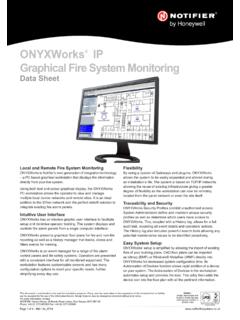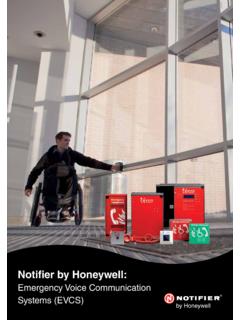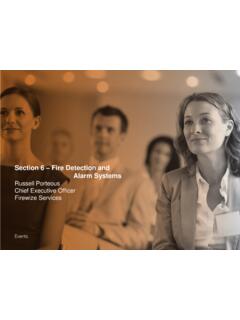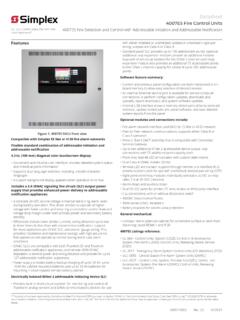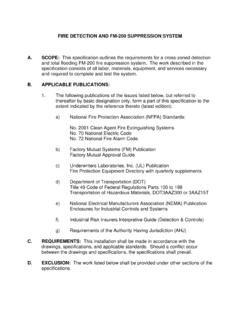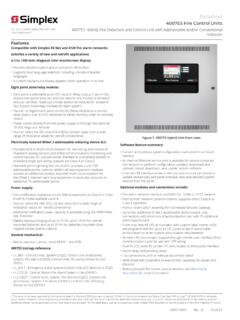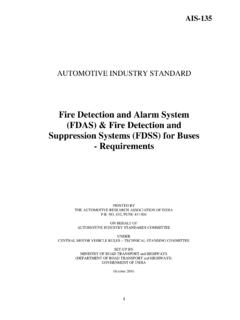Transcription of Fire detection systems
1 fire detection Systemscontentsintelligent fire alarm systemsconventional fire alarm systemsdetector application guide4915 fire detection systems 8/8/06 11:46 Page 3principle of operationA conventional fire alarm systemnormally consists of a control panellinked to a number of lines of firedetectors and manual call points,normally called detection zones,and a number of sounder or alarmcircuits. A simple system is shownin Figure panelThe control panel drives thedetection zones and soundercircuits, provides LED indications of fire , fault or normal conditionsand contains switches to allow thesounders to be activated or silencedand the detectors to reset followingan alarm. The control panel ispowered from the mains (230 VAC)and will contain back-up batteriesto allow the system to function for a minimum of 24 hours, dependanton the application, in case of amains : There are numerous suppliersof fire control equipment and firedetection devices.
2 There is noguarantee that all panels and alldetectors are electricallycompatible. Therefore, to avoidpotential incompatibility issues, it isstrongly recommended to purchaseboth groups of products from thesame source, or to obtainconfirmation of compatibility fromthe panel detectionand alarmzonesMost conventional fire alarm panelshave several detection zonescomprising a mixture of automaticfire detectors and manual callpoints. In order to limit the effect offaults, and to limit the search area inthe case of a fire , the size of a firedetection zone is limited to 2000m2,with a maximum travel distancewithin the zone to locate a fire of60m. In addition, zones should notcover more than one storey, unlessthe total floor area of the building isless than 300m2. As a result unlessthe site is very small, the system willcomprise several detection fire alarm (or sounder) circuit maycover more than one detectionzone, but it must follow theboundaries of the relevant detectionzones, and the boundaries shouldbe of fire resisting firealarm systemsFIREALARMCONTROLPANELEOLEOLFIREDE TECTIONZONE 1 EOLFIREDETECTIONZONE 2 FIREALARMCIRCUITZone 1 AlarmSystem OKZone 2 AlarmZone 1 FaultZone 2 FaultAlarm Cct FaultSystem ResetFigure 1: Simple conventional fire alarm systemFire detection systems 8/8/06 11:46 Page 4conventional systemoperationdetection line operationConventional detection systemsnormally operate on a 24 VDC the standby condition, thedetectors will draw a low current,typically less than 100 A.
3 When thedetector senses a fire , it will switchinto the alarm condition with it'sLED illuminated, and will collapsethe line voltage by drawing a largercurrent - dependant on thedetectors and control panel, buttypically 50-80mA. The controlpanel can sense this, and activatethe appropriate alarms. Thedetector will remain latched in thealarm state with its LEDsilluminated, even if the smoke orheat is removed until it has beenreset from the panel by momentarilyremoving power from the line. This allows the fire to be locatedeven if the signal is intermittent, orto locate possible sources ofnuisance some control panel - detectorcombinations, when a standardbase is used, there is anincompatibility between the currentspecifications of the detector andpanel, leading to incorrect reportingby the control panel, for examplesignalling a fault in place of analarm, and in some cases damageto the detector due to over currentin the alarm state. In these cases itis necessary to use a base fittedwith a resistor in series with thedetector to limit the current draw in alarm.
4 Resistors fitted into thedetector base are also used in some cases to distinguish betweena short circuit fault and an alarm. The value of the base resistor isdependant on the control panel,however a typical value is 470 Ohms. If in any doubt, contact thecontrol panel manufacturer whoshould be able to specify whichdetector bases should be used with different detector manual call-point consists of asimple switch with a resistor inseries with it, usually 470 Ohms or680 Ohms. When the call point isactivated, the resistor is switchedacross the line, and a current of 50-80mA, dependant on the control panel, is line fault monitoringStandard conventional systems areable to monitor the zone for shortcircuit, open circuit and detectorhead a short circuit occurs on azone, a high current will be drawn,and the line voltage will be pulledtowards zero volts. The paneldetects the low voltage / highcurrent and a fault is order to detect an open circuit, ordetector head removal, a device isconnected across the end of thezone, which can be monitored.
5 This device can take various formsdependant on the control +24 VContact Closedwhen detectorinserted in baseResistorFigure 2: Resistive end of line operationFire detection systems 8/8/06 11:46 Page 5 The simplest end of line device is a resistor, which will draw a currentdistinct from the quiescent andalarm currents drawn by thedetectors. Installation of detectorsinto their bases closes a contact inthe base supplying the remainder ofthe zone. Thus if the line is broken,or if a detector head is removed, the current drawn by the zone willfall, and a fault will be signalled (See figure 2). Example zone currentand voltage figures are given in figure problem with a simple resistiveend of line is that should a detectorhead be removed, the remainder ofthe zone beyond that detector islost and no alarm can be signalledbeyond this point. Should a callpoint be mounted beyond theremoved detector, it will no longerwork, which contravenes therequirements of BS5839 part 1.
6 Toovercome this either all call pointsmust be mounted at the start ofeach zone, or in completelyseparate zones (both of thesesolutions are often impractical andtoo costly), or head removalmonitoring can be monitoring uses bases fittedwith a diode across the contact inthe base (fig 4). Whilst the detectoris mounted in the base, the basecontact connects directly across thediode, and links it out. There isusually provision for manuallylinking the diode out to permitcontinuity testing duringcommissioning. When the detectorhead is removed, the diode isconnected across the contact,allowing power to continue to besupplied to the remainder of thezone, whilst still permitting theremoved detector to be is achieved in a number of active end of line device uses aswitched resistor at the end of lineand can thus be used with astandard control panel. It sends aperiodic signal back along thedetection line, which is normallyquenched by the control a head is removed, the basediode is switched into the line, andpulse can be seen.
7 The Active endof line then switches the resistor outof the line, and a fault is signalled. If a capacitive end of line is used,the panel periodically drops the linevoltage for a few milliseconds, andlooks for the line voltage being heldup by the capacitor. When a head isremoved, the panel will see the linevoltage drop immediately as thecapacitor's discharge will beinhibited by the diode, and therebya fault can be third type of end of line device isa diode. With this the panelperiodically reverses the line voltagefor a few milliseconds: If the line isbroken by the diode in the detectorbase, then no current can flow inthe reverse type of end of line monitoringused on a system will depend on the control panel. However it is important, particularly when using active end of line monitoring60V+ Closeswhen detectorinserted in baseFigure 3: Example resistive conventional system current and voltage figuresFigure 4: Active end of line monitoring circuitMonitoring of detection line(example only)ConditionCurrentVoltageOpen Circuit<3mA24 VNormal5mA (dependant on EOL device)18 VFire50mA (dependant on control panel) 4 15 VShort CircuitHigh (dependant on control panel)0 VFire detection systems 8/8/06 11:46 Page 6to ensure that the detectors are compatible with the type of monitoring being used.
8 Reference must be made to the panel manufacturer to ensure LEDsMost system smoke detectors areequipped with a terminal to allowthe connection of a remote LEDs are often usedoutside bedroom doors in hotels sothat in case of a fire , it is easy forthe fire brigade to identify thelocation of the fire without needingto enter every room in the may also be used where adetector is located in a hiddenposition, such as a floor or roof voidor cable tunnel, for example, toprovide a visual indication that thedetector is in an alarm system operationIn some cases it is necessary thatthe power to the detectors and thefire detection signal be on separate wires, see figure 5. In this instance,a base incorporating a change overrelay is used. This configuration isknown as a four-wire system, and isoften seen when a fire zone isintegrated into a security 5 shows the simplest form offour-wire system, as used with mostsecurity panels . This is used wherethe monitor line is able only toregister an open or closed circuit -there is no distinction between afault and a fire .
9 By using a normallyclosed relay at the end of the powerline, it is possible to monitor for apower failure to the detectors. Therelay contacts are wired in serieswith the normally closed contacts ofthe detector relay base(s). Thus inthe normal state the detectioncircuit is closed; in the case of fireor power failure the relevant relaycontacts will after an alarm, thedetectors are reset by disconnectingthe power to the relevant zone for ashort period by pressing a centralpanel reset button. fire panels havethis facility built in, however manysecurity panels are unable to do thiswithout turning the entire panel to allow the use ofdetectors with security panels , non-latching versions of the relaybases are usually made available,which automatically isolate thedetector from the supply every fewseconds. Thus once the firecondition has passed the detectorwill automatically reset (note thatthe alarm condition should belatched at the control panel.)
10 Four-wire type systems are alsooften used with devices such asbeam detectors where an auxiliary7 CNO NCCNO NCEnd of LineMonitoring RelayFIREALARMCONTROLPANELD etection Line(Open Circuit forAlarm and Fault)Power Supply(Nominal 12 Vor 24V System)ALARMRELAY (N/O)FAULTRELAY (N/C)MAINTENANCERELAY (N/C)+24 VDC IN- 24 VDC OUT+ 24 VDC OUT- 24 VDC INALARMRELAY (N/O)FAULTRELAY (N/C)MAINTENANCERELAY (N/C)+24 VDC IN- 24 VDC OUT+ 24 VDC OUT- 24 VDC INEOLBEAM DETECTOR #1 BEAM DETECTOR #2+ 24 VDCDETECTION CIRCUIT- 24 VDCPOWER SUPPLYEND OF LINERELAY COILR esistorResistorFigure 5: Typical 4 wire system wiringFigure 6: 4-wire system with full monitoringFire detection systems 8/8/06 11:46 Page 7power supply may be required. Inthis case if the device is connectedto a fire control panel, able todistinguish between differentdetector states, the circuit can berouted to provide full monitoring foralarm and fault. Figure 6 showstypical wiring for a beam detector,which includes it's own internalmaintenance and fault this layout all fault andmaintenance contacts are wired inseries, and all alarm contacts inparallel with the end of line the case of a fault ormaintenance signal, the end of linewill be disconnected, and a faultcan be signalled at the panel.


